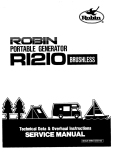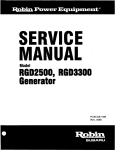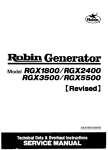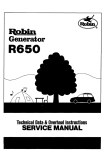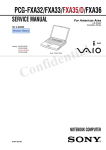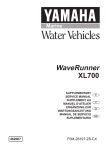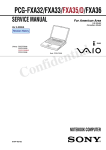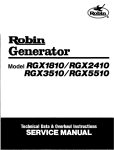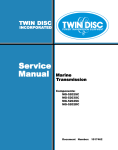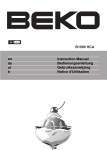Download R1300 GENERATOR SERVICE MANUAL
Transcript
Model WITH EMISSIONCERTIFIEDENGINE PUB-GS1185 Rev. 4198 Section 1 . 2. . 4. 3 5 . . . 6 7 . 8 . . 9 . 10 11 . . 12 Title Page 1 SPECIFICATIONS Generator T- TY Pe Brushless, self-exciting, 2-pole, singlephase, revolving field Frequency 60 Hz AC Voltage (Rated current) 120V (8.3 A) Max. 1300 W AC Output : Rated DC Output I ’j 12V- 8.3A (100W) I Condenser system I ForcedAir-cooled,4-Stroke,SideValve, Gasoline Engine : I Type I Displacement I 8.73 cu. in (143 cm’) Ii 2.48 x 1.81 in (63 xmm) 46 i Bore x Stroke Fuel 1ooow I Voltage regulation system Engine I (unleaded) Gasoline 1 Automotive Fuel tank capacity I 0.9 U.S. gal (3.5 liters I 1.3 U.S. pints (600cc) I Approx. 3.6 hours i I Oilcapacity pan 8 Continuous operating hours pertank 1 starter 1 Recoil Ignition system ignition state Solid I system Starting I I Dimensions (L X W X I H) 19.3 x 11.3 x 16.1in (490 x 288 X 41Omm) I II Dry weight Specifications are subject to change without notice. -1- 60.6 Ibs. (27.5 kg) 2. PERFORMANCE CURVES 2-1 AC OUTPUT 7300 1200 1000 800 A I 600 s e 3 E 3 0 400 200 1 2 3 4 5 6 7 9 10 11 CURRENT(A) 2-2 DC OUTPUT Thevoltage curve shownin the left indicates the characteristic of DC output when charging a battery. The voltagemay be decreased by 20% when the resistance load is applied. ” 0 2 4 6 CURRENT (A) 8 10 -2- 3. FEATURES 4 LOW-NOISE Mounting of Air-cooled, 4-Cycle, Super Side Valve ROBIN Engine (EYlSD-SSVR) and introduction of a larger muffler into the machine realized low-noise operation. 0 LIGHT-WEIGHT COMPACT The machine is easy to carried about due to itslight-weight (27.5kg) and compact design. 0 HIGH OUTPUT (increased maximumoutput) The 1300W outputis an increase of lOOW over the 6OHz maximum output of the current R1210. 0 EASY OPERATION The one-touch engine control switch integrates the engine on/off switch and the choke. All controlsare conveniently located on the frontpanel. 0 LONG OPERATION The large 0.9 U.S. gal. (3.5 liter) fuel tank allows about rated load. 0 3.6 hours of continuous operation at 60Hz -d MINIMAL MAINTENANCE The brushless design and condenser voltage regulator system ensure maintenancefree operation. 0 FUNCTIONAL FEATURES The AC/DC push button circuit breaker allows for easy and safe operation when an overload occurs or when the machineis not functioning properly. Equipped with voltmeter for reading AC output voltage. DC output can be obtained for the re-chargeable battery. 0 NOISE PREVENTION Resistor spark plug prevent electric-wave noise for radio, T.V., etc. 0 OIL SENSOR (optional) Theoilsensordetects when oildecreasesbelow preventing engine damage. the designatedlevel,stoppingtheengine -3- and 4. GENERAL DESCRIPTION 4-1 EXTERNAL VIEW of GENERATOR control Engine DC terminal Frequency adjusting ,screw (internal) switch (CHOKE-RUN-STOP) 1 starter cockFuel ' I Fuel strainer \ I warning Oil lamp (With oil sensor type) \ \ Muffler Air cleaner cover Carrying handle . Fuel tank cap Drain plug Oil filler cap Fig. 4-1 -4- 4-2 LOCATION of SERIAL NUMBER and SPECIFICATION NUMBER Serial number and specification number are stampedon the LABEL (MODELNAME) stuck on the fuel -1 tank. NOTE: Always speciiy these numbers when inquiring about the generator or ordering spare parts order toget correct parts and accurate service. Label (Model name) \ Fig. 4-2 -5- in 5. CONSTRUCTION AND FUNCTION 5-1 CONSTRUCTION 6P coupler \ r l l Rotor complete Rear cover 'I Condenser Diode rectifier rubber Mount ' \\ Stator complete I I \ Stator cover Ball bearing Through bolt Fig. 5-1 5-2 FUNCTION 5-2-1 STAT0 R The stator consists of a laminated silicon steel sheet core,amaincoil and acondensercoil which are wound in the core slots. The condenser coil excites the rotor field coil which generates AC voltage in the main coil. Fig. 5-2 - 6 - Front cover 5-2-2 CONDENSER A condenser is mountedontherear cover andis connected to the condenser coil which is wound on the stator. This condenser and condenser coil regulate the output voltage. Fig. 5-3 5-2-3 ROTOR The rotor consists of a laminated silicon steel sheet core and field coil which wound is over the core. DC current in thefieldcoilmagnetizesthesteel sheet core. Two permanent magnets are provided for the primary exciting action. A coolingfan is pressure-fitted on the endofthe rotor shaft to cool thecoils, cores, rectifier, and other generator parts. (See Fig. 5-4) Fig. 5-4 A diode rectifier and resister are mounted inside the .insulator. (See Fig.5-5) of Cooling air is sucked by the rotor fan through the slits of therearcoverand is expelled through the outlets of the front cover. Fig. 5-5 -7- 5-2-4 CONTROL PANEL The control panel has a double AC receptacle with a ground terminals, and DC terminals. The voltmeter displays output voltage of the generator. The circuit breaker for AC and DC protects the generator from getting damages caused by overloading or defective appliance. Fig. 5-6 - 8 - 5-3 GENERATOROPERATION PERMANENT MAGNET FOR INITIAL EXCITATION SURGE ABSORBER I I I ‘CONDENSER Fig. 5-7 5-3-1 GENERATION Of NO-LOADVOLTAGE When the generator starts running, the permanent magnet built-in to the rotor generates 3 to 6V of AC voltage in the main coil and condenser coilwound on the stator. As one or two condensers are connected to the condenser coil, the small voltage at the condenser coil generates a minute current@ which flows through the condenser coil. At this time, a small flux is produced with which the magnetic force at the rotor’s magnetic pole is intensified. When this magnetic force is intensified, the respective voltages in themain coil and condenser coil rise up. As the current@ increases, the magnetic flux at the rotor’s magnetic pole increases further. Thus the voltages at the main coil and condenser coil keep risingby repeating this process. As AC current flows through the condenser coil, the density of magnetic flux in the rotor changes. This change of magnetic flux inducesAC voltage in the field coil,and the diode rectifier in the field coil circuit rectifies this‘ACvoltage into DC.Thus a DC current @ flows through the field coil and magnetizes the rotor core to generatean output voltagein the main coil. When generator speed reaches 3000 to 3300 r.p.m. , the current in the condenser coil and field coil increases rapidly. This acts to stabilize the output voltage of each coils. If generator speed further increasesto the rated value, the generator output voltage will reach to the rated value. 5-3-2 VOLTAGE FLUCTUATIONS UNDER LOAD When the output current@ flows through the maincoil to the appliance,a magnetic fluxis produced and serves to increase current @ in the condenser coil. When current @ increases, the density of magnetic w fluxacrosstherotor core rises. As aresult,thecurrentflowinginthefieldcoilincreasesandthe generator output voltageis prevented from decreasing. -9- - 5-3-3 DC OUTPUT DC output is taken out from the DC coil and is fed to the diode stack (rectifier) where the output undergoes full-waverectificationand is then suppliedtothe load. The diode works to allow the current toflow in to the direction @, but does not allow the current flow in the direction 8, as shown in Fig. 5-8-1. 4 -a -0 Fig. 5-8-1 Fig. 5-8-2 shows the DC output circuit of the generator. DC voltage is generated in the DC coil. When the voltage in A is higher than that in Cythe current @ flows in the direction shown in the figure, while nocurrentflows between B and C becausethe current is cut off by the diodes D,. On the contrary, when the voltage in C is higher than that in A, the current @ flows in thedirection as shown in the figure.No current flows betweenA and B because the current is cut off by the diodes D,. + Dl Main coil Fig. 5-8-2 As a result, the voltage generated at the output terminal has a wave form with two peaks in one cycle, as in the case of the output wave form shown in Fig. 5-8-3. Between A and 6 \ 1 / '"0 -. Between 0 / I \ c and B / - / \ \ Output waveform I '\ \ j 0 Curre'nt flowing between A and B flowing between C and B Fig. 5-8-3 - CAUTION : Do not use DCand AC output simultaneously. Due to a characteristic of the condenser voltage regulation, simultaneous use of DC and AC output creates voltage drop In DC output resultingin incapability for charging batterles. - 10 - 5-4 ELECTRONIC IGNITION SYSTEM The electronic ignition system features a power transistor as the current control element. Therefore, the ignition system is an electronic contact point-free type that operates with the power transistor impulses 4 controlling the current. This system is also called TIC (transistor igniter circuit) and is virtually free of ignition failure which generally results from contamination of the contact points, a typical problem with contact type ignition systems. Because this ignition system has no contact points, it is not affected by moisture, oil, dust, or other contaminants. As a result, this electronic ignition system ensures sure and positive ignition with reduced maintenance. The TIC mechanism consists of a transistor-incorporated ignition coil and a permanent magneto built-in flywheel which is press-fitted on the rotor shaft of the generator. Fig. 5-9 (1) When the permanent magneto built-in flywheel start rotating, power is generated in the primary coil of the ignition coil and current flows to theresistor @ . From the resistor, current flows the power transistor. With this current, the power transistor turns on, releasing current This stagecorresponds to theclosing of contact points. (2) As the flywheel comes to the point of ignition, timing detecting circuit is activated while the current @ is flowing through the circuit. When the ignition timing detecting circuit is activated, the signal transmitter transistor actuates with current @ flowing. When current@ starts flowing,current @ flowing through the power transistor is cut quickly. As a result, high voltage is produced in the secondary coil and this voltage is applied simultaneously to the spark plug which ignites forignition. This stage corresponds to the opening of contact points. a. - 11 - 5-5 OIL SENSOR (OPTION) - 5-5-1 DESCRIPTION 0 0 The oil sensor mainly functions to detect position of thesurface of engineoilinthecrankcase of engines for generaluse and tostoptheengine automatically when the oil level goes down below the lower limit specified. This prevents seizureof engine from occurring due to insufficient amount of oil in the crankcase. Since the sensor has been designed to consume a part of power supplied to the igniter to energize its electronic circuit, any other external power supply is not necessary so that it can be mounted at the oil filler port. Introduction of newly developed sensing principle features super durability and no change with the passage of time as it does not use any moving part. I I I i I I i ! i 1i \ oil sensor Fig. 5-10 Merits due to introductionof electrical conductivity detectionare asfollows; has resistance to mechanical shocks and property of no change with the passage of time as sensing element consists simplyof electrodes having no moving parts. @ At the same time, it is capable of detecting the oil level stably as it is not influenced by engine vibrations. @ No error occurs due tofoam and flow of the oil. @ Influence against the ignition system or the electronic units can be neglected because an electric current supplied to the sensor can be decreased. 0 It - 5-5-2 PRINCIPLE OF SENSING OIL LEVEL There is a great difference between electric resistanceof air and that of oil. Since the resistance of air is far higher than that of oil, more electric current passes through the oil than through the air, although absolute valueof the current is very smalI. The sensor detects this current difference and make use of it. The sensor judges the oil quantity,by comparing a current flowing across a pairof electrodes (inner and outer) with the reference, in such a way that if a current flows between the electrodes more than the reference, sufficient oil is in the crankcase, on the other hand, if a current flows less than the reference, oil is not sufficient. Sinceanelectriccurrentisflowntodetectoilquantity,this is calledthe“electricalconductivity detection” type of sensor. The oil level to be detected is determined by the length of electrodes and their mounting positions with the engine. 5-5-3 HOW IT OPERATES ’ ” [Power supply] The sensor makes use of a part of primary power source for ignition of the engine (igniter) to drive the sensor circuit. Powerto the sensor can usually be derived from the ”stop button”by branching wires out. - 12 - [Judgement of oil level] When sufficient oil is in the crankcase, bothof inner and outer electrodes are immersed in the oil through whichcurrentflowsacrosstheelectrodes.Thesensorjudgesthatoil in the crankcase is sufficient. 4 When oil level goes down and the inner electrode is exposed to the air due to consumption of oil, no current flow between the electrodes as isairconsidered to be electrically non-conductive. The sensor in this case judges that oilis insufficient. [Decision of oil shortage] Oil level at the electrodes may go down momentarily probably due to the engine being slanted or affected by vibration even if a sufficient oil isin the crankcase. For that reason, the sensor has an electronic timer circuit to prevent it from interpreting as short of oil when amount of oil is sufficient. The sensor has been designed so that the engine is to be stopped only when oil-shortage is detected for 5 seconds uninterrupted. The timer employs an integration circuitand it is to be reset when the inner electrode is soaked in the oil again before the sensor decidesit as oil-shortage. The oil level where the sensor decides as oil-shortage, when oil level goes down gradually, is called “threshold level”. [Automatic stopof engine] When the sensor decides as oil-shortage, it makes the engine tostop running automatically for protection of engine. Once the stopping circuit is activated, it keeps functioning until it confirms that the engine has made a complete stop, thenthe circuit stops functioning automatically. e 5-5-4 BLOCK DIAGRAM OF THE CIRCUIT Power circuit Igniter LED indicator I Inner pole oil - Detection circuit - Deley circuit Outer pole Stopping circuit Engine Fig. 5-1 1 0 Power circuit----*-*---This rectifies a part of power to the igniter and regulates it to supply the stabilized power to necessary circuits. - 13- -1 @ Detection circuit*****-* This detects quantity of oil, sufficient or not, according to difference of electric resistanceacross inner and outer electrodes. Delay circuit **.*.-**.-* This prevents the sensor from making an unnecessary stop of the engine by momentary lowering of the oil level due to theenginebeing slanted or affected by vibration in spite of sufficient oilin the crankcase. @ stopping circuit - - * * * - This automatically stops the enginerunning. Also, the LED indicator for warning can be’ lit while the engine is being stopped. We have the wires to be connected to LED available. 5-5-5 CAUTIONS TO BE TAKEN ON HANDLING THE SENSOR (1) Oil sensor unit 0 Be sure not to damage each wire. Broken or short-circuited power supply wires and/or a grounding wire in particular may lead to malfunction or breakdown. (2) Mounting and wiring of oil sensor unit 0 Although this has been designed to have enough anti-noise properties in practical use, do not route the sensor wirings in the vicinity of noise-generating sources such as ignition plugs or high voltage cords. This may cause malfunction or breakdown. ” @ Since capacity of power source is limited, current flown in the electronic circuit of the sensor is kept as low as possible. Be sure to use terminals with a high contact reliability of more than that of tinned terminals. (3) Operation of oil sensor 0 If operating with the engine kept tilted, oil surface inside of the engine varies and the correct oil level can not to be detected which in turn obstructs the preventing function of engine seizure. Operate the engine by keeping it level. @ When starting the engine with an insufficient oil in the crankcase, engine starts once then it stops automatically after it runs for about 5 seconds. @ When the engine has been stopped by the oil sensor, voltage remained in the electronic circuit prevents the sensor frombeing re-started for 3 seconds after the engine stop. Try to re-start the engineafter 3 seconds or more. - 14- 6. Use extremecaution near fuel. Aconstant danger of explosion or fire exists. 4 Do not fill the fuel tank while the engine is running. Do not smoke or use open flame near the fuel tank. Be careful not to spill fuelwhen refueling. If spilt, wipe it and letdry before starting the engine. Do not place inflammable materials near the generator. Be careful not to put fuel, matches, gunpowder, oily cloth, straw, and any other inflammables near the generator. Do not operate the generator in a room,cave or tunnel. Always operatein a well-ventilatedarea. Otherwise the engine mayoverheat and also, the poisonous carbon monoxide contained in the exhaust gases will endanger human lives. Keep the generator at least 1 m (4 feet) away from structures or facilities during use. Operate the generator on a level surface. If the generator is tilted or moved during use, there is a danger of fuel spillage and a chance that the generator may tip over. Do not operate with wet handsor in the rain. Severe electric shock mayoccur. If the generator is wet by rain or snow, wipe it and thoroughly dry it 4 before starting. Don’t pour water over the generator directly nor wash it with water. If the generator is wet with water, the insulations will be adversely affected and may cause current leakage and electric shock. Do not connect the generator to the commercial power lines. This may cause a short-circuit or damage to the generator. Never connect the generator to the existing house wiring. If connected, the generator will burn out when the commercial power sourceis recovered. Don’t operatethe generator with its cover removed. The operator may be injured or suffer electric shock. CAUTION; If the circuit breaker tripped off as a result of using an electrical appliance, thecause can be an overload or a short-circuit. In such a case, stop operationimmediately and carefully check the electrical appliance andplugs for faulty wiring. - 15- 7. 7-1 AC OUTPUT Generally, the power ratingof an electrical appliance indicates the amount of work that canbe done by it. The electricpowerrequiredforoperating an electricalappliance is not alwaysequaltotheoutput wattage of the appliance. The electrical appliances generally have a label showing their rated voltage, frequency, and power consumption (input wattage). The power consumption of an electrical appliance is the power necessary for using it. When using a generator for operatingan electrical appliance,the power factor and starting wattage must be taken into consideration. In order to determine the right size generator, it is necessary to add the total wattage of all appliances to be connected to the unit. Refer to the followings to calculate thepower consumption of each applianceor equipment by its type. Incandescent lamp, heater, etc. with a power factor of 1.O Total power consumption must be equal toor less than the rated output of the generator. Example: A rated 1OOOW generator can turn ten lOOW incandescent lamps on. Fluorescent lamps, Motor driven tools, light electrical appliances, etc. witha smaller power factor Select a generator with a rated output equivalent to 1.2 to 2 times of the power consumption of the to 3 load. Generally the starting wattageof motor driven tools and light electrical appliances are 1.2 times lager than theirrunning wattage. Example: A rated 250W electric drill requires a400W generator to start it. NOTE 7: If a power factor correction capacitor is not applied to the fluorescent lamp, the more power shall be required todrive the lamp. NOTE 2: Nominal wattage of the fluorescent lamp generally indicates the output wattage of the lamp. Therefore, if the fluorescentlamp has no special indication as to the power consumption, efficiency should be taken into account as explained in item (5) on the following page. Mercury lampswith a smaller power factor Loads for mercury lamps require 2 3totimes the indicated wattage during start-up. Example: A 400W mercury lamp requires 800W to 1200W power source to beturned on. A rated 1OOOW generator can power one 400W mercury lamp Initially loaded motor driven appliances such as water pumps,compressors,etc. These appliances require large starting wattage which is 3 to 5 times of running wattage. Example: A rated 9OOW compressor requires a 4500W generator to drive it. NOTE 1: Motor-driven appliances require the aforementioned generator output only at the starting. Once their motors are started, the appliances consume about 1.2 to 2 times their rated power consumption so that the excess power generated by the generator can be used for other electrical appliances. (3) and (4) varyintheirrequiredmotor NOTE 2: Motor-drivenappliancesmentionedinitems starting power depending on the kind of motor and start-up load. If it is difficult to determine the optimum generator capacity, select a generator with a larger capacity. - 16- Appliances without any indication as to power consumption Some appliances have no indication as to power consumption; but instead the work load (output) is indicated. In such a case, power consumption is to beworked out according to thenumerical formula mentioned below. (Output of electrical appliance) (Efficiency) * -- (Power consumption) Efficiencies of some electrical appliances are asfollows: Single-phase motor * 0.6 0.75 The smaller the motor, the Three-phase motor * * * * 0.65 0.9 >lower the efficiency. Fluorescent lamp - - - 0.7 0.8 ----- ---- --- --------- --- -- Example 1: - A 40W fluorescent lampmeansthat its luminous output is 40W. Its efficiency is 0.7 and accordingly, power consumption will be 40 + 0.7= 57W. As explained in Item(2), multiply this power consumption value of 57W by 1.2 2 and you will get the figure of the necessary capacity of a generator. In other words, a generatorwith a rated output of 1OOOWcapacity can light nine to fourteen 40W fluorescent lamps. Generally speaking, a 400W motor means that its work load is 400W. Efficiency of this motor is 0.7 and power consumption will be 400 + 0.7= 570W. When this motor is used for a motor-driven tool, the capacity of the generator should be multiplied by 1.2 to 3 and 570W as explained in the item(3). - Example 2: Applicable wattage Appliance 60Hz lncandesent lamp, hot plate I I up to lOOOW I Fluorescent lamp, mercury lamp, Electric tool I up toabout 800W to about 250W Pump, compressor up I I I I I Table 7-1 NOTES: Wiring between generatorand electrical appliances 1. Allowable current of cable Use a cable with an allowable current that is larger than the rated input current of the load (electricalappliance). If the input currentis larger thanthe allowable currentof the cable used, the cable will become excessively heated and deteriorate the insulation, possibly burning it out. Table 7-2 shows cablesand their allowable currents for your reference. 2. Cable length I f along cable is used, a voltage drop occurs due totheincreasedresistanceinthe conductors decreasingthe input voltage to the load(electrical appliance). As a result, the load can be damaged. w Table 7-2 shows voltage drops per 100 meters of cable. - 17- Sectional mm' Allowable A Gauge No./ wlre element No./mm 0.75 7 3010.18 1.25 12 5010.18 2.0 17 23 5.5 current I area Voltage 37 10.26 3.5 35 45 10.32 7010.32 Table 7-2 Voltage drop indicates as V = 100 X R X I X l R means resistance ( 52 /lo0 m) on the above table. I means electric current throughthe wire (A). 4! means the length of the wire (m). The length of wire indicates round length, it means twice the lengthfrom generator to electrical tools. 7-2 DC OUTPUT NOTE :Do not use DC and AC output simultaneously. Due to a characteristic of the condenser voltage regulation, simultaneous use of DC and AC output creates voltage drop in DG output resulting in incapabilityfor charging batteries. When the generator is employed to charge batteries, attentions should be paid to the specific gravity of electrolyte in the battery. 7-2-1 SPECIFIC GRAVITY O F BATTERY ELECTROLYTE The specific gravityof electrolyte variesby temperature ;so it must be converted to the one at20°C. S20 = St + 0.0007 (t-20) where S20 : The specificgravity at 20°C St : Measuredvalue t : Temperature at the time of measurement (Electrolyte) - 18 - 7-2-2 SPECIFIC GRAVITY OF BATTERY ELECTROLYTE AND CHARGING CONDITION Remarks Charglng condintion Specific gravity (20.c) 1.260 100 1.240 87 1.220 75 1.200 62 1.180 50 1.160 37 Charging is not necessary. Charging is necessary. Immediate Chargingis necessary. I 1.140 1 I 25 7-2-3 BATTERY CAPACITY The battery capacity is expressed in the unit of AH (ampere-hour). One AH stands for the capacity one hour. capable of one ampere current for - 19- w 8. MEASURINGPROCEDURES 8-1 MEASURING INSTRUMENTS 8-1-1 “Dr.ROBIN” GENERATOR TESTER The“Dr.Robin”generatortester signed for fast, easy diagnosis generators. is exclusively deand repair of Robin The “Dr. Robin” has the following features: (1) Functions of voltmeter, frequency meter, megger tester, capacitance meter and circuit tester are combined in one unit. (2) Fast and easy readout by digital indicator. (3) Built-in automatic battery checker indicates the I Fig. 8-7 time to change batteries. (4) Tester and accessories are installed in a handy, sturdy case for easy carrying. 0 SPECIFICATIO US Dr. Robin Model 0-5OOV AC Voltage a m Frequency 25-70HZ .K Resistance 0.1 -1,999 R 8 Condenser Capacity 10-100 ,uF insulation Resistance 3MR d CI) 5 ’ s I Circuit Protector I PowerSource I Test leads with needle probes . . .1 set Accessories Dimensions (L X W I Fuse Test leads with jack plugs. X 285 mmx200 rnmxl10 mm H) Weight . . . . 1 set I 1.6kg Table 8-1 The “Dr. Robid’generator tester can be ordered from Robin generator distributors by the following part number. I Dr. Robin Part Number :388-47565-08 1 - If you do not have a “Dr. Robid’generator tester,use the instruments described for checking generator parts. - 20 - in the following section I 8-1-2 INSTRUMENTS VOLTMETER AC voltmeter is necessary. The approximateAC voltage ranges of the voltmeters to be used for various types of generators are asfollows: 0 to 15OV: Type with an output voltage of 110 or 120V 0 to 300V: Type with an output voltage of 220, 230 or 240V 0 to 150V, 0 to 330V: Dual voltage type For AC fig. 8-2 (2) AMMETERS AC ammeteris necessary. An AC ammeter with arangethatcan be changed according to the of agivengenerator is most currentrating desirable. (About 10A, 20A, 1OOA) For AC Fig. 8-3 (3)METER FREQUENCY Frequency range : About 45 to 65Hz NOTE: Be careful of thefrequencymeter’s input voltage range. I Fig. 8-4 - 21 - -1 (4) - CIRCUITTESTER is used for measuring reThiscircuittester sistance, etc. I Fig. 8-5 (5) MEGGER TESTER Used formeasuringgenerator insulation resistance. Select one with testing voltage range of 500V. Fig. 8-6 (6) ENGINETACHOMETER There are various types of tachometers, such as contactless type, contact type, and strobe type. The contacttypecanbe usedonly when the generator and engine have been disassembled. The contactless type isrecommended. The PET-2100E engine tachometer is available from your Robin distributors. Please inquire by the part number PET-2100E. Fig. 8-7 - 22 - 8-2 AC OUTPUT MEASURING 4 To AC receptacle Fig. 8-8 Measurement is executed with the circuit as shown in Fig. 8-8. An electric heater or an incandescent lamp with a power factor of 1.0 is suitable as a load for the generator. When the AC output measured at the rated load and rated speed is confirmed to be within the voltage range specified in the table below, the AC output is normal. I voltage Rated I Voltage range 120v I 117-1 30V Table 8-2 8-3 DC OUTPUT MEASURING II To DC Terminal -l P Fig. 8-9 Measurement of DC output is executed with the switch turned ON while the current is regulated at 8.3A by adjusting the load to the generator. If the voltage is within the range from 6V to 14V,the voltage output is normal. Note : If a battery is connected as a load to the generator, the DC outputvoltagewillincreaseby approximately I to 2V. Therefore, carefully observe the electrolyte level and do not overcharge the battery. - 23 - 8-4 MEASURING INSULATION RESISTANCE Use a “Dr. Robin”generator tester in megger tester mode or use a megger tester to check the insulation resistance. Connect a megger tester to one of receptacle output terminals and the ground terminal, then measure the insulation resistance. An insulation resistance of 1 megohm or more is normal. (The original insulation resistance at the time of shipment from the factory is 10 megohm or more.) If it is less than 1 megohm, disassemble the generator andmeasure the insulation resistance of the stator, rotor and control panel individually. fig. 8-70 0 - I STATOR (1) Measure the insulation resistance between BROWN lead and the core. (2) Measure the insulation resistance between YELLOW lead and the core. (3) Measure the insulation resistance between BLACK lead and the core. J I Fig. 8-11 0 ROTOR Measure the insulation acrossone of the soldered terminals of the rotor and the core. Fig. 8-12 - 24 - 0 CONTROL PANEL Measure the insulation resistances between parts and the grounded parts. the live I I Fig. 8-13 Any part where the insulation resistance is less than 1M8 has faulty insulation, and may cause electric leakage and electric shock. Replace the faulty part. -1 - 25 - 9. CHECKING FUNCTIONAL MEMBERS 9-1 CONTROL PANEL Fig. 9-1 9-1-1 AC RECEPTACLES Using a “Dr. Robin”or a circuit tester, check continuity between the two terminals at the rear of the AC receptacles while the receptacle is mounted on the control panel. When continuity is found between the output terminals of the receptacle with a wire connected across these terminals, the AC receptacle is normal. When the wire is removed and no continuity is found between these terminals, the receptacles are alsonormal. - Fig. 9-26 Fig. 9-2A - 26 - 9-1-2 DC TERMINAL Check continuity between the DC terminals at the rear of the control panel using a circuit tester, under the condition that the DC terminals is mounted on the control panel. (See Fig. 9-1.) When continuity between the DC terminals is confirmed with a wire connected across the terminals, and is not confirmed if the wireis removed, the DC terminals are normal. (SeeFig. 9-1.) 9-1-3 CIRCUIT BREAKER Check continuity between the two terminals at the rear side of the circuit breaker using a circuit tester while it is mounted on the control panel. If continuity is confirmed when the breaker is ON, and no continuity is confirmed when the breaker is OFF, the circuit breakeris normal. 9-14 VOLTMETER Check the voltmeter if it operates correctlyby applying specified voltage. Voltmeters caunot be checked with a circuit tester because its internal resistance is too large. AC Voltmeter Fig. 9-3 9-2STATOR I Disengage connectors on the wires from stator and check the resistance between wires with a “Dr. Robin” or a circuit tester referring to the following table. I Fig. 9-4 - 27 - w (RxlR +lo%) - Specification AC Windlng DC Windlng Condenser Winging Hz Voltage Brown I White Green I Green Black / Black 60 120v 1.4 Q 0.62 Q 4.8 R Table 9-1 NOTE: If the circuit tester is not sufficiently accurate$ may not show the values given and may give erroneous readings. Erroneous reading will also occur when there is a wide variation of resistance among coil windings or whenmeasurement is performed at ambienttemperaturesdifferentfrom ZO"C(68"F). 9-3 ROTOR 1) Using the "Dr. Robin"or a circuit tester, measurethe resistance ef the field coil. (See Fig. 9-5.) (RxlR+10%) - Resistance NOTE I: Because a diode is soldered to the coil ends at the terminals, resistance may be measured only when tester probes touch the terminals in one combination of polarity.Therefore, if noresistancereading appears, trychecking in reverse polarity. NOTE 2: If the circuit tester is not sufficiently accurate, it may not show the values given and maygive erroneous readings. Erroneous reading will also occur when thereisa wide variation of resistance among coil windings or when measurement is performed at ambient temperatures different from20°C (68°F). 2) Measure the resistance of the resister. _- - 28 - Fig. 9-5 9-4 CONDENSER w Use a "Dr. Robin" in capacitance meter mode to check the capacity of condensers. (See Fig. 9-6.) NOTE: Be sure to discharge condensers byshorting condenser leads each other before checking their capacitance,or the accurate reading cannotbe obtained. 10 ,uF Fig. 9-6 If such an instrument is unavailable, the condenser can be checked by replacing with anew one. If thegeneratorperforms good with new condenser, thecause of trouble is defect in original condenser. 9-5 DIODE RECTIFIER Green Green Geen> Green Fig. 9-7 4' h Diode rectifier Circuit tester\ Fig. 9-8 The internal circuitof the diode rectifier is as shownin Fig. 9-7. Check continuity between each terminal using a circuit tester as shown in Fig. 9-8. - 29 - Checking table for analogue circuit tester. ~~~ ~ ~ ~~~ ~ ~~ ~ ~~ ~ ~~ ~ Apply blackOneedle of the clrcult tester Analogue clrcult tester Green Green Green Apply red @ needle of the clrcult tester Red No continuity Green Red Checking table for digital circuit tester. Apply red @needleof the clrcult tester Digital clrcult tester Red Green Green No continuity Green Apply black 0 needle of the clrcult tester Green Red Table 9-2-2 _NOTE 1: Because of the difference of measuring method between the analogue circuit tester and the digital circuit tester, polarityof tester needles shouldbe reversed, NOTE 2: “Continuity” means forward direction characteristics of the diode, and different from short circuit condition (in which a pointer of thetestergoes out of its normal scale),shows resistance to some extent.Whenresult of thecheckingindicates failure eveninone section,replace with a new one. NOTE 3: “Simpson“ brand analogue testers have the characteristic as same as the digital circuit tester. L - 30 - 9-6 OIL SENSOR (OPTION) 1.Disconnect two (2) wires comming from the sensor atthe connection. 2. Loosen the sensor to remove it from the engine. 3. Plug the opening of oil filler hole (created after sensor is removed) with suitable means such asoil gauge. 4.Connecttheremovedwires sensor. again withtheoil ~~ ~ Fig. 9-9 5. Start the engine with the oil sensor removed and confirm if; a. Engine stops after5 seconds which is normal, or b. Engine does not stop after more than 10 seconds whichis unusual. NOTE : The sensor will not operate properly when wireis broken or poorly connected. Check the wires for correct connection. If it fails to stop within5 seconds after the wirings have checked, the sensor is wrong. Replace the sensor with new one. 10. DISASSEMBLY AND ASSEMBLY 10-1 PREPARATION and PRECAUTIONS 1) Be sure to memorize the location of individual parts when disassembling the generator so that the generator can be reassembledcorrectly.. Tag the disassembled part with the necessary information to facilitate easier and smoother reassembling. 2) For more convenience, divide the parts into severalgroups and store them in boxes. 3) To prevent bolts and nuts from being misplaced or installed incorrectly, place them temporarily back at their original position. 4) Handle disassembled parts with care; clean them before reassembly using a neutral cleaning fluid. 5) Use all disassembly /assemblytools properly, and use the proper tool for each specific job. - 31 - 10-2 DISASSEMBLY PROCEDURES c Tool itep - ~~~ ~~ 1. Side cover (1) Removethesidecover by unscrewing four M5 X 8 screws. (See Fig.10-1.) (+)Plus screw driver 2. Rear cover (1) Remove the rear cover (+) Plus driver by unscrewing three M5 X 8 screws and two M8 X 10 screws. (See Fig. 10-2.) Fig. 10- 1 3. Control panel Fig. 10-2 (+) Plus driver (1) Pull the knob off the control lever and remove the control panel by unscrewing four M5 X 8 screws. (See Fig. 10-3.) I I Fig. 10-3 - 32 - 'I 'art to remove Couplers and plugs (D' Isconnection) I Description Tool Remarks of statorwiresPull the couplerswhile from the wires of control panel. pushing the locking 6P couplers (Yellow, Red, Green/ hook. Yellow, Brown,White) (1) Disengagethecouplers (See Fig. 10-4.) (2) Disengage the connectorsof oil warning lamp (option) (See Fig. 10-5.) \ Fig. 10-4 Press the hookof the coupler and pull out to disconnect. of the coupler and Press the hook pull out to disconnect. CONTROL PANEL SIDE STATOR SIDE Fig. 10-5 - 33 - Tool 'art to remove ~ 5. Front cover (1) Remove the element cover by unscrewing M6 X 12 screw. (See Fig. 10-6.) (-) Driver (2) Remove the front cover by unscrewing three M5 X 8 screws. (See Fig. 10-6.) (+) Driver 1 Element cover Fig. 10-6 6. Fuel pipe and plug (Disconnection) (1) Discharge fuel from thetank. 1. Shut the fuel striner. 2. Remove the strainer cup. 3. Put a vessel to receive fuel under the strainer andopenthefuelcock to discharge fuel.(SeeFig. 10-7.) 4. Attach the strainer cup to the strainer body Use utmost care about fire hazard. Wipe off spiltfuel throughly. Do not lose the filler screen. Pliers (2) Disconnect fuel hose from the strainer. Loosen thehoseclamp on topof the strainer and pull out the fuel hose from the strainer. (See Fig. 10-8.) I I Fig. 10-8 Fig. 70-7 - 34 - Step 7. 'art to remove Fuel tank handle I Description (1) Remove the handle coverby unscrewing the two M3 X 10 screws. Remarks The fueltank can be removed without disassembling the handle. (2) Pull off the breatherpipe. (3) Remove the handle body by taking off the two M8 nuts. I Tool (+) Driver 12mm box wrench Handle cover M3 x -1 I M8 Nut (2 pcsj Fig. 10-9 - 35 - Part to remove Fuel tank Remarks Description Tool lOmm box wrench (1) Remove the two M6X 12 flangebolts from the blower housing. (See Fig. 10-10.) (2) Remove the fuel tank by taking off the two M8 nutsfrom the bottom of the tank. (SeeFig. 10-11.) 12mm box wrench Fig. 10-10 Bracket (Cover) I Fig. 10-17 12mm box wrench (1) Removethebracket cover from the generator by loosening the two M8 X 30 bolts. (See Fig. 10-12.) I I End cover (1) Removethe end coverfrom the generator by unscrewingthe four M5 X 10 screws. (See Fig. 10-12.) Fig. 10-12 - 36 - (+) Driver I step I Part to remove I 11. Rear bracket I Description Remarks Tool (1) Loosen and take out the three M6 cover bolt. (See Fig. 10-13.) lOmm box wrench (2) Remove condenser from rear bracket. Box spanner (3) Removetheconnector Box spanner and screw driver (+) of thediode rectifier and then removethe earth cable terminal from the rear bracket. (See Fig. 10-14.) Fig. 10-13 I I Fig. 10-14 (4) Remove the rear bracket,tappingit evenly with a plastic mallet. (See Fig. 10-15.) Plastic mallet (5)Remove mount rubbers from rear cover. (See Fig. 10-16.) Wrench Fig. 10-16 Fig. 10-15 - 37 - 12. Stator I Descrlptlon Itep Part to remove Tool Remarks (1) Remove the stator cover. (See Fig. 10-17.) (2) Pulloff the stator from the front cover Never tapping the core.with a plasticmallet.winding (See Fig. 10-18.) tap on the and thelead. Plastic mallet Fig. 10-18 Fig. 10-17 n cover \ Fig. 10-19 Fig. 10-20 - 38 - Step 'art to remove 13. Rotor Remarks Descrlptlon - Box wrench Plastic hammer (1) Take off the through bolt. Applya boxwrenchontheheadof through bolt. Hitthe wrench handle with a hammer counter-clockwise to loosen. Fig. 10-21 (2) Putthe engine ontheworkingtable recoil starter side down. (3) Use a bolt and oil as a tool for pulling out rotor in the following procedures: 1. Pour engine oilinto the center holeof rotor shaft. Fill with oil to the shaft end. (See Fig. 10-22.) 2. Prepare aboltwiththefollowing thread size : M8 X P 1.25 3. Apply a few turns of seal tape around the tip of the bolt. (See Fig. 10-23.) I Fig. 10-23 Fig. 10-22 - 39 - Tool Dart to remove 13. Rotor I Descrlptlon 4. Screw the bolt into the thread of the rotor shaft. 5. Torque the bolt using a socket wrench until the rotor comes off loose. * The hydraulic pressure inside the rotor shaft takes apart the rotor fromthe engine shaft. Remarks Tool 12mm box spanner or Socket wrench (4) Wipe off oil throughly from rotor shaft and enginePTO shaft. Fig. 10-24 14. Front bracket (1) Remove the frontbracket,which mountedonthemainbearingcover the engine, by taking out four M8 bolts. (SeeFig. 10-25.) X is of 18 Fig. 10-25 - 40 - 12mm box spanner Part to remove Tool Remarks Description I Mount rubbers (1) Remove mount bracketfrom engine. Remove mount rubbers from mount bracket. 8 q.5 Nut : S p a . or 2pcs. ~ Mount bracket \Mount rubber Fig. 10-26 - 41 - 12 mm wrench 10-3 ASSEMBLY PROCEDURES ” 10-3-1 FRONT BRACKET Install the front bracket on the main bearing cover of the engine, engaging the faucet joint. (See Fig. 10-27.) M8 X 18mm bolt and washer assy -.***..-..-* 4pcs. TIGHTENINGTORQUE 1175 - 10.1 f t Ibs. 9 1370N-crn 140 kg = cm Fig. 10-27 10-3-2 ROTOR 1) Wipe off oil from thetapered portion of engine shaft and matchingtapered hole of rotor shaft. (See Figs. 10-28 and 10-29.) Fig. 70-29 Fig. 10-28 Install rotor on the engine shaft and tighten the through-bolt. Apply a wrench on the head of through bolt and hit wrench handle clockwise with a hammer to tighten. (See Fig. 10-30.) If an impact wrenchis available, use it. I TIGHTENING TORQUE 1175 120 8.7 I I 10.1 ft Ibs. 1370N-cm 140 kg cm I Fig. 10-30 - 42 - 10-3-3 STATOR Holding the rear bracket and stator, fit them to the front bracket. Match the mounting hole of the rear bracket and that of the rotor bearing, and softly strike the outsideperiphery of the rear bracket with a plastic hammer. (See Fig. 10-31.) Attach the stator cover around the stator. Fig. 10-31 Tighten the three M6 boll i to fix the rearbracket to the front bracket. TIGHTENINGTORQUE 535 55 4.0 5.4 ft Ibs. 735 N cm 75kg-cm (4) Put the grommet in the grooveof the rear bracket and secure the wire. Note :Fix the wire from the stator and diode stack with the clamp at the bottom of the groove. 10-3-4 CONDENSER Put condenser to rear cover. 5 0 X 10 mm tapping Screw ----..----*.----.. 2 pcs. TIGHTENINGTORQUE 2.4 325 - - - 4.0 ft Ibs. 535 N cm 55 kg cm Condenser Fjg. 10-32 -43- 10-3-5 ENDCOVER " Set theend cover on the rear bracket with four M5 X 10 screws. 10-3-6BRACKET(COVER) Mount the bracket (cover) on the rear bracket and secure them with M8 X30 bolts. Fig. 10-33 10-3-7 FUEL TANK AND FUEL PIPE (CONNECTION) (1) Connect the rubber pipe to the engine carburetor and fasten it with a hose clamp. Attach the banjo to the opposite end of the rubber pipe, tighten it with a hose clamp, and fasten the pipe to the fuel strainerwith the banjobolt. Note :Mount the fuel strainer with the banjo outlet upward. _ - (2) Fasten the strainer to the front bracket with the joint nuts. (3) Secure the mounting tabon the bottom of the fuel tank and the blower housing with M6 X12 bolts. Insert the attaching bolts on the other end of tank into the mount bracket hole andsecure it with two M8 nuts. (4) Connect the rubber pipe First, fit the hose clampon the rubber pipe, connect the strainer and fuel tank, then fasten the rubber pipe with the hose clamps. Note :Apply a drop of oil to the rubber pipe so that it may easily be connected to the strainer and the fuel tank. 10-3-8 FUEL TANK HANDLE (1) Match the handle hole with the bolt on the top of the fuel tankand secure it with M8 nuts. (2) Completely insert the breather pipe over the bolt. Note :There is a hole at the center of the breather pipe for air bleeding.Set the breather pipeso that the hole is directed upward. (3) Fix both ends of the handle cover with M3 X 10 screws. - 44 - Handle cover M3 x 10 Screw (2 pcs.) -1 To Carburetor I s Hose clamp Fuel strainer "..,Rubber hose / M8 Nut (2 pcs.) clamp Hose Fig. 10-34 10-3-9 FRONT COVER AND ELEMENT COVER (I) Secure the frontcover, on which fuelstrainer have been mounted, with three M5 X 8 screws. (See Fig. 10-35.) (2) Secure the element cover with M6 X 12 screws. (See Fig. 10-35.) Element cover F@. 10-35 - 45 - - . 10-3-10 CONNECTION OF WIRES (1)Connectthewiresdrawnout from thestatorto the wires from the control box. (See Fig. 10-36.) \ (2) Press the couplers untilthe locking hook engages securely. (3) Connect the oil warning lamp (option) wire. (See Fig. 10-36.) fig. 10-36 [WIRE CONNECTIONS BETWEEN CONTROL PANEL AND STATOR] 6P coupler Wire color : Yellow, Red, GreenrYellow, Brown, White Green / Yellow Green / Yellow STATOR SIDE CONTROL PANEL SIDE 10-3-1 1 CONTROL PANEL (1) Put the control panel over the control lever and M5 screws. secure it with four (2) Attach the knob to the control lever. Note :After the couplers and connectors have been connected and secured to the control panel, secure the wireswithawireband to the control panel. c Fig. 10-37 - 46 - 10-3-12 REAR COVER Secure the rear cover with three M 5 X 8 screws and two M8 X 10 screws. Fig. 70-38 10-3-13 SIDE COVER Secure the side cover with four M 5 X 8 screws. - 47 - - 11 = TROUBLESHOOTING 11-1 NO AC OUTPUT 11-1 -1 CHECKING STATOR 1) Remove control panel and disconnect couplers on wiring. 2 ) Measuretheresistancebetween terminals on stator leads. Refer toTable 9-1 (page 28) for normal resistance. [Remedy] If stator is defective, replace with new one. Fig. 11-1 11 -1-2 CHECKING CONDENSER w If an instrument (Q.C.-meter or C-meter) for measuring capacity of condenser is available, check the capacity of condenser. NORMAL CAPACITYOF CONDENSER 1OpF w If you do not. have such an instrument, you can check condenser by replacing with new one and test running. If the generator perform normally with new condenser, condenser. 1 1-1 -3 CHECKING ROTOR 1) Remove rear cover and stator. - 48 - the cause of trouble is defect in original 2) Measure the resistance of field coil with a circuit tester. (See Fig. 11-3.) (R x 195 10%) NORMAL RESISTANCE lRemedy1 If theresistance with new one. is not normal, replace rotor Fig. 11-3 3) Check the magnetic force of magnets molded in the rotor. [Remedy1 1. If the magnetic force is weak, replace the rotor with a new one. 2. If the diode or the resistor is faulty, replace rotor assembly with new one. When all removed these parts aregood, assemble them and then solder. 11-2 AC VOLTAGE IS TOO HIGH OR TOO LOW 11-2-1 CHECKING ENGINE r.p.m. . If the engine r.p.m. is too high or too low, adjust it to the rated r.p.m. mow to adjustengine r.p.m. .] Loosen the nut on theadjusting screw. H Turntheadjustingscrew clockwise toin decreaseenginespeedor counter-clockwise to increase engine speed. Normal engine speed at no load is : 3750 3800 r.p.m. . d - 11-2-2 CHECKINGSTATOR Check stator referring to Step 11-1-1. Fig. 7 1-5 11-2-3 CHECKING CONDENSER Check condenser referringto Step 11-1-2. 11-2-4 CHECKING ROTOR Check rotor referring to Step 11-1-3. - 49 - I I 0 0 Resistor AC circuit breaker Robin America, Inc. 940 liieiy Blvd. - Wood Dale, It 60191 . Phone: 630-350-8200 . Fax: 63Ir350-8212 e-mail: sales Orobinamerica.com R1300 www.robinamerica.w m 0 Copyright 1998 Robin America, Inc. ‘90 - 4






















































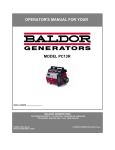
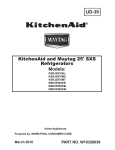
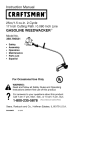
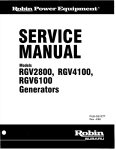

![PLAS A O ]-OR](http://vs1.manualzilla.com/store/data/005852706_1-5db0b7ed584537f0e62af161fb124638-150x150.png)

